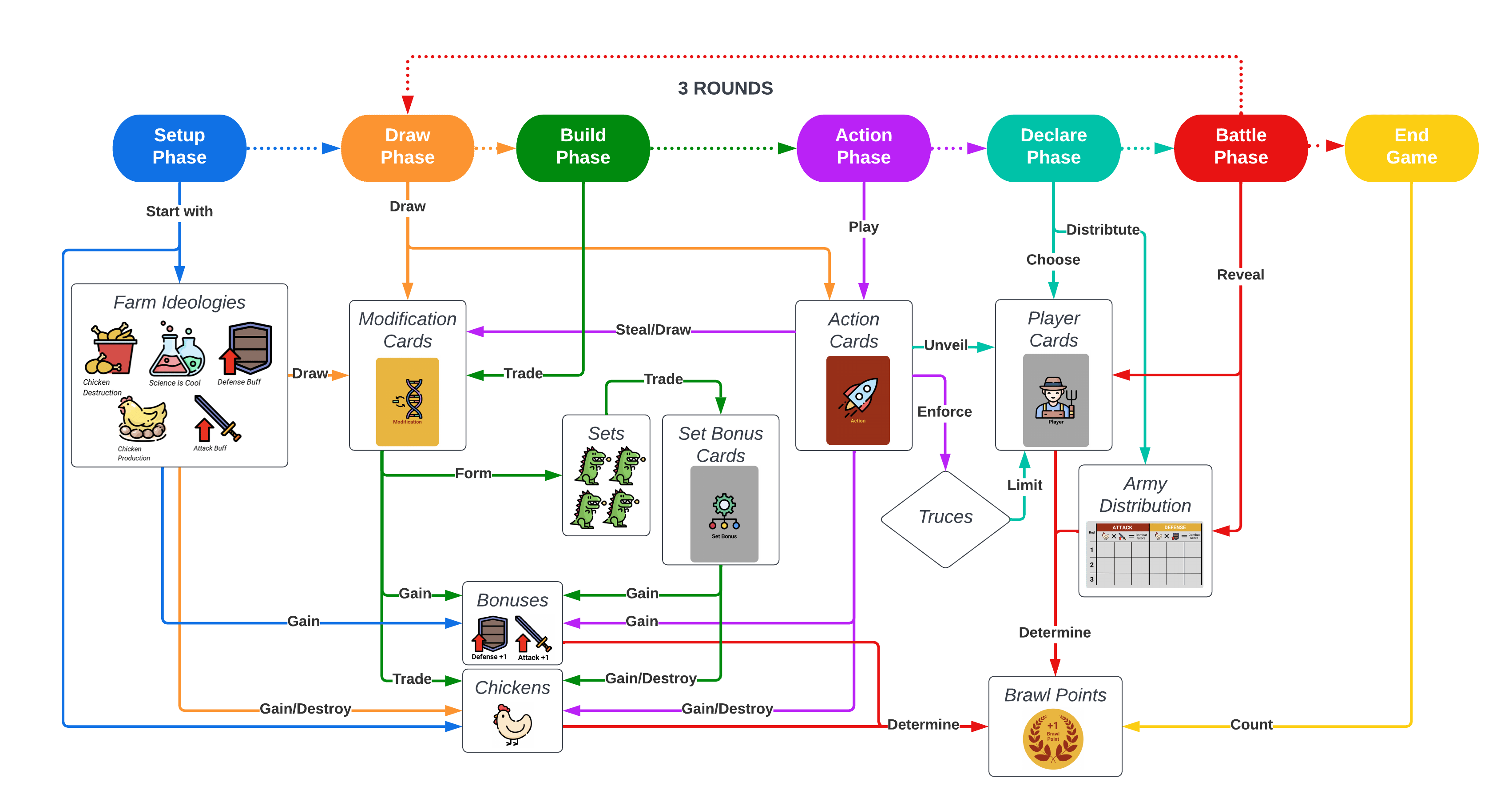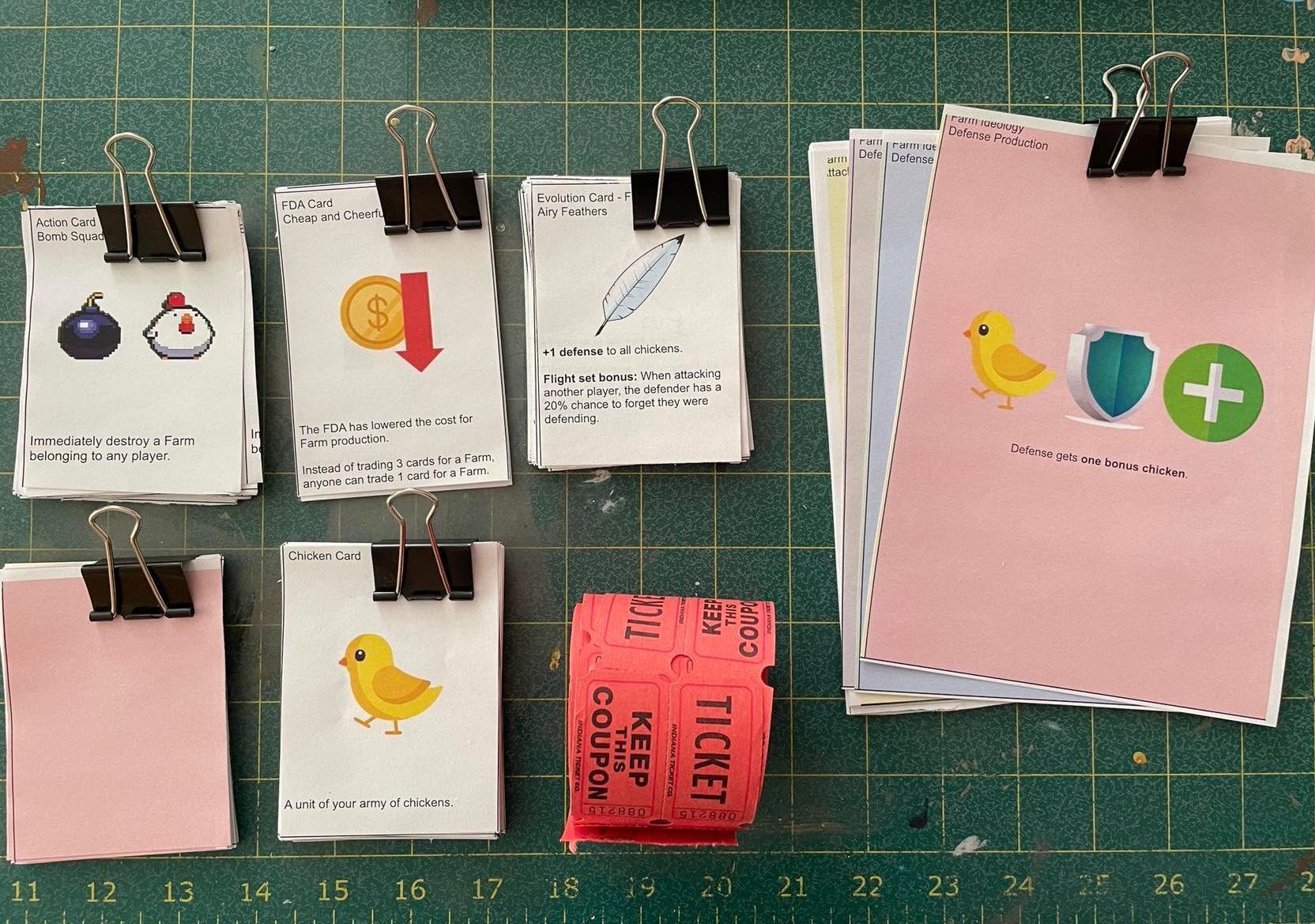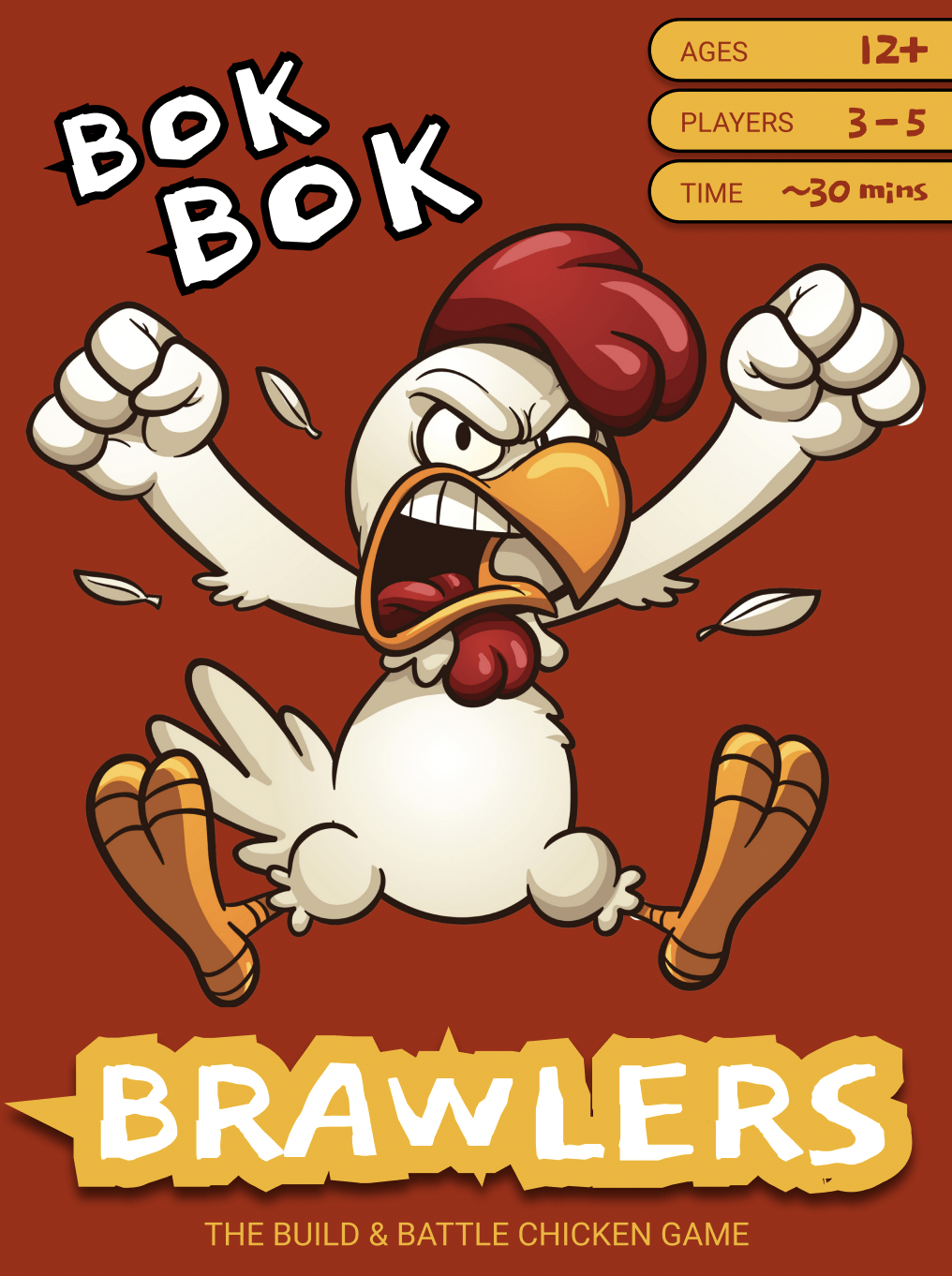Project 1 Final Deliverables
Bok Bok Brawlers by Esteban Wu, Katherine Chen, & Ethan Huang
Artist’s Statement
Bok Bok Brawlers was inspired by party games like Exploding Kittens and Unstable Unicorns, with aspects of 7 Wonders thrown into the mix. We were looking to create a game whose mechanics inspired fellowship, cooperation, negotiation, and deceit, but didn’t necessarily require them as rules to play the game. As such, we wanted to appeal to those looking for a game that could be played with friends, family, or strangers, but with more depth than a game like Exploding Kittens. Our cartoonish graphic design choices were made to match the rather whacky, chaotic theme that we’d chosen. We realized that betrayal, attacking, and stealing could be potentially spiteful or malicious, so we hoped that the art would reinforce the idea that the players are simply playing a game, and these actions should not translate outside the boundaries of the game.
On a personal note, we all share a love for playing card games, and wanted to create battle mechanics that were unique in the card game space. Most of our efforts went into creating our battle system, and we’re quite excited with the result. We hope you have as much fun playing Bok Bok Brawlers as we did making it!
Concept Map

Figure 1. Concept map of Bok Bok Brawlers.
Initial Decisions (Formal Elements and Values)
Initially, we started from the prompt “Genetically-modified chicken battle royale.” This starting point helped to inform some of the formal elements and values that we wanted to express. “Battle royale” implied a multilateral player model, while the “genetically-modified chicken” portion gave us the impression of whacky, crazy fun. We imagined that this kind of game would fit under fantasy, fellowship, and narrative, however the final product aligns more with just fellowship and challenge.
When considering resources, we originally thought of physically building something in some sort of 3D-medium, but we soon realized that time restraints and lack of a good fighting mechanic that wouldn’t result in damage to the game would make this avenue unrealistic. Instead, we tried to create a battle system using cards that would mimic the build-and-battle style game we had in mind. We would start with a build phase, where players would build up their chicken or army of chickens, and then a battle phase, where players would fight with the armies or chickens that they had built up. Genetic modification cards would allow players to customize these chickens in some way to gain advantages over other players. For the actual mechanics of the game, we liked 7 Wonders’ simultaneous reveal mechanic, and used it to create suspense and a negotiation dynamic in our game. Genetic modification cards could be traded to complete sets, which we hoped would also foster that negotiation and interaction dynamic between players.
Lastly, we fleshed out the objective of the game: win the most battles against other players. We felt that this was a simple enough goal to provide some conflict, as we didn’t want to further complicate the game considering our already complex mechanics.
Testing and Iteration History
- First full playtest: 4/12, in class, with other students who had never played before (3 people).
- Goal: In our first playtest, we aimed to determine if our initial game was too complex (spoiler alert: it was). We specifically wanted to see if our battle mechanics and set mechanics functioned properly so that people could actually get through a game.
- What we learned: The game was far too complex. Having to collect 4 specific cards in a set was too difficult and unintuitive because their icons didn’t match. Players never collected enough to actually unlock set bonuses. Additionally, the timer during the negotiation stage was unused for the most part. We also realized that sometimes players were forced to lose more victory points than they actually had, which was disastrous as their combat power was tied to the number of points they had. Finally, we noticed that players were having trouble keeping track of their attacking and defending armies.
- Changes we made: We simplified sets to be just matching 4 of the same icon together, and made it very clear what bonus was being gained with sword and shield icons. Rule sheets were revamped to be more clear with images, and we removed farms to separate victories from army strength. This also simplified the number of cards and pieces. All farm ideologies were also given a base +1 attack and +1 defense to start with. We also added army tracking sheets for people to write down their army distributions.
- Second full playtest: 4/14, in section, with our team members (3 people).
- Goal: test the new set system, set bonuses, and combat scoring.
- What we learned: As we were all familiar with the game, we were able to quickly get into the game and start playing. The biggest thing we noticed was that our set bonuses were not balanced and took much too long to calculate with percentage values, along with farm ideology bonuses and action cards. Additionally, we realized that FDA cards provided very little to the game while adding additional pieces that needed to be kept track of.
- Changes we made: We removed the FDA cards and rewrote all set bonuses to be much simpler without percentage values. The decision was also made to allow players to trade in their sets for set bonuses, as it cleared up the board and encouraged different strategies. Farm ideology boards and action cards were rewritten to be at the start of the battle phase or build phase to reduce complexity in calculating combat scores. We really wanted combat score calculation to just be as simple as the number of chickens multiplied by the number of the proper bonus type.
- Third full playtest: 4/19, in class, with students who hadn’t previously played the game (6 people).
- Goal: Our goal for this playtest was to test out the maximum number of players to see if the mechanics and negotiation would be too chaotic. Additionally, we wanted to check the balancing of the new farm ideology boards, action cards, and set bonuses. Furthermore, we needed to see if the order and flow of the game and phases made sense, or if there were contradictions that needed to be addressed. Finally, we wanted to experiment with a new scoring system, where players would receive and lose the difference between the combat scores of the two armies.
- What we learned: 6 players seemed to be just a little bit over what the players could handle in terms of keeping track of each other. It was also not very clear when certain action cards could be played, and we also realized that action cards drawn in the third round would be rendered useless due to the ordering of phases. Furthermore, we saw a need to establish some type of order in resolving combats with so many people. Finally, the new scoring system resulted in huge point swings that didn’t really make sense.
- Changes we made: We moved the drawing cards action in order for action cards to remain relevant in the third round of play. Additionally, we cut our max player count down to 5, and reverted back to the old one point per win and minus one point per loss scoring system. We also implemented a temporary system where the player with the blue player card began resolving combat first, but we hope to come up with something better in the future. We also considered adding an “Action Card Phase” between the build and battle phases to simplify ambiguous timings, but have not yet been able to test it.
- Fourth full playtest: 4/20, during game night, with TAs and students (5 people).
- Goal: We aimed to record our playtest video and try out drawing cards according to the new phase order. This playtest was also used to test the stability of the old single point scoring system and lower player count.
- What we learned: The thing that we found most important from this playtest is that we needed to increase the clarity of the rules, especially via the rule reference card. It also seemed difficult to keep track of the start of phase permanent buffs and action cards without reminders, with some players being confused to what phase the game was in. Additionally, players found the combat system confusing without proper explanation or examples.
- Changes we’d like to make: We’re currently working on increasing the clarity of the rules by creating a much clearer, concise rules reference card (with lots of images!) and an accompanying rules handbook. As such, we rewrote what is considered a phase to be more in tune with our playtests, and so that everything could fit on a succinct rule card. Additionally, we’ve created playmats to help players organize and keep track of their various cards and tokens. We would also like to revamp the score sheets to make it easy to calculate combat score in one action and keep track of current brawl point totals. In the future, we’d like to make army distribution buckets that players can physically put their chicken tokens into separate armies. Similarly, we’d like to add a score tracker where players move their markers up and down the track, so that all players can see the current state of the game and players don’t have to add up their scores at the end. Lastly, we’d like to simplify the phases into several easy steps, and introduce a turn order for action cards and persistent effects in order to decrease chaos a bit and increase clarity.
Iteration of Game Art and Materials

Figure 2. First iteration of game art and materials.
- First iteration of game art
- First iteration of rules
- Second iteration of game art (Note that the art style is very similar to the final version of the game.)
- Second iteration of rules
- Box design
Final Prototype Link/Embed (Print and Play)
Prototype link (Note that the final rulebook is attached at the end.)
Full Playtest Video



